We picked out our mix, we demo’d our kitchen, and made new countertop templates. Next up in Project Concrete Countertops is the forms.
If you’re making DIY concrete countertops, one of the most important parts of the process is the forms. Your forms are your molds, and if they’re not done right, your end product won’t look professional and you’ll constantly be bothered by those little bits that are “off” (or just straight up wrong).
Before taking on this project, I researched a LOT about the forms, and got a bit freaked out. Most of the things I’d read about the forms involved making a completely level work surface for the forms, (which would be a problem in our tiny unlevel garage) and a whole lot of pre-drilling, countersinking and screws screws screws. Then comes the stressful part about making your perfect edges with caulking.
Then Jeremy from Buddy Rhodes Concrete Products entered our life, and told me to chill out about the forms. They really weren’t that hard. We should build them with tape instead of screws, and not to worry cause if we mess something up it doesn’t matter, as we can just pull the tape up and do it again. They also don’t have to be level, just flat. Because OUR Buddy Rhodes concrete wouldn’t be poured, and therefore didn’t have to fill the forms completely, and thus no need for level.
As for the edges, Jeremy told us to pick up some Vaseline and Popsicle sticks, and he’d show us how to do the edges the easy way.
So Jeremy took a stressful, detail orientated task and made it a whole lot simpler.
So here’s what you need to make your forms:

- 3/4″ 4×8 melamine sheets (we used 2) $38/each
- Strips of melamine cut to the desired depth of your countertop. In our case we were building a 1 1/2″ thick countertop, and therefore got our strips cut to 1 1/2″. You CAN do this yourself on a table saw, however it is a hard task to push 4×8 sheets onto a table saw getting perfectly straight strips. It is much easier to have Home Depot or Lowes cut them down with their panel saw. Get more strips cut than you think you’ll need. We got 4. Not enough.
- Double Sided Duct Tape (*This can be hard to find. In the US check Walmart or Lowes. In Canada we did not find it anywhere, and resorted to double sided Scotch carpet tape (which did work). We ended up using 5 rolls of carpet tape, so make sure you have a bunch on hand. We started with 3 and had to make a trip back to HD.)
- Off cuts of your 3/4″ thick melamine to use as spacers for your countertop overhang
- 100% white silicone caulking. The white dries harder than the clear, so go for white. Again get more than you think you need.
- Caulking gun
- Disposable rubber gloves
- Shop Towel (or heavy duty paper towel)
- Vaseline
- Popsicle Sticks
- Miter saw
- Flat work surface (we used saw horses with 2×4 vertical stretchers between to stop sagging for one work surface, and a bunch of 5 gallon paint buckets for the other.)


HOW TO MAKE CONCRETE COUNTERTOP FORMS
Step One:
Make your flat work surface, ensuring you can get to all sides of the work surface, and you’re not going to trip over anything. Place a 4×8 sheet of melamine on your work surface, ensuring the melamine is in good condition. The surface has to be flat because you’re making your countertops upside-down. If there’s sag your countertops won’t be flat!
Step Two:
FLIP YOUR TEMPLATES UPSIDE DOWN, and transfer any imperative markings such as overlaps and sink holes to the bottom. The flipping your templates upside down is CRITICAL! (Yes, we did learn this one from making a BIG mistake. We got so excited to start building the forms that we forgot to flip them and had to start all over again.)
Place your (upside down) templates onto your melamine and lay them out to maximize your space. (a.k.a. don’t put one big template smack dab in the middle, fit them around like a puzzle so that you’re not wasting space)
Step Three:
Start building the edges of your forms using your template as a guide. Now you don’t have to measure each piece exactly to build your frame, its actually easier if you cut your sides a bit long, and build the sides of your form like this:
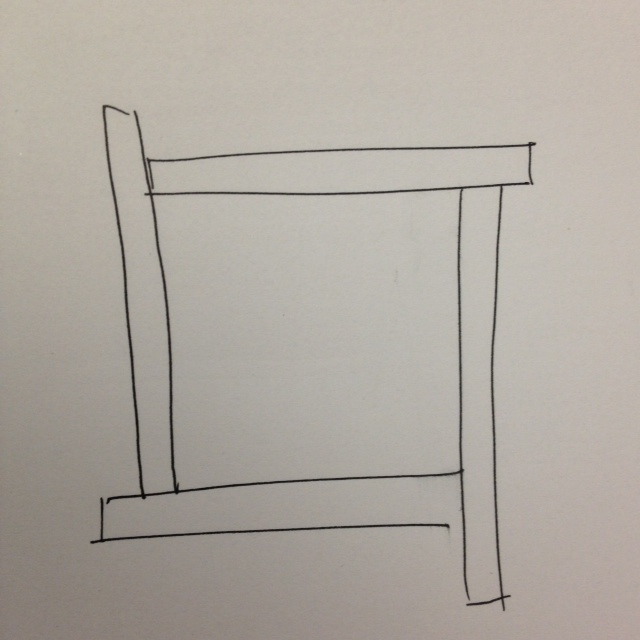
Follow your templates, and where its indicated to add an overhang of 3/4″ inch, place a few offcuts of your melamine between the template edge and your melamine side to create the perfect spacing. Once you have everything laid out, attach the form sides to the melamine sheet base using the double sided tape. For added strength, use a self tapping screw (such as a pocket hole screw) to screw through the corners of your form, attaching the side pieces together. No need to screw into your 4×8 melamine sheet base though, the double sided tape will hold everything good enough. Also if you don’t screw in to your base sheet you can reuse it later on for another project!

Step Four:
If you have any really wavy/crooked walls, and you needed to make a curved template (like we did for the coffee bar). Now it is time to make your curved form. To make the curve, we made kerf cuts on the back of one of our melamine strips. We first applied the double sided tape to the bottom of the piece, then set our miter saw to only cut through half the material, then kerfed all along where the curve needed to be.

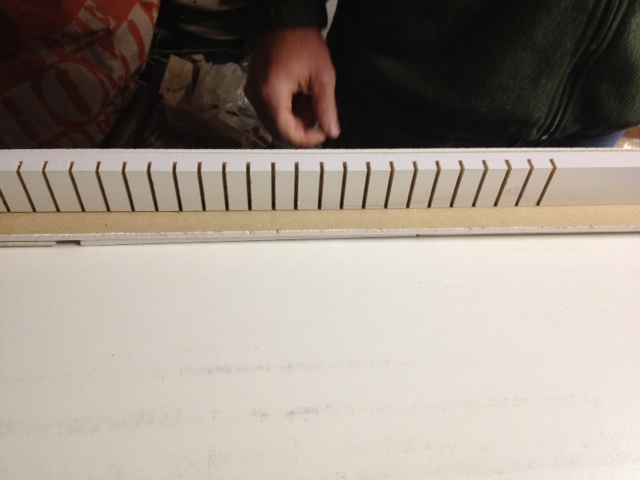
Once it was kerfed, we checked to see if it would curve to the form, then stuck it down, and added a few screws to keep it in place. A pretty big feat of engineering.


Step Five:
Make any special forms. This will include sink cutouts, and in our case a WATERFALL. Yep that’s right, my dream of a waterfall countertop was happening! Whats a waterfall counter you ask? It’s when the countertop appears to drop off the side of a counter to the floor. Like this:

I really wanted the countertop on the peninsula to have a waterfall, and Jeremy said it was not only possible, but that we could do it in ONE PIECE. Yeah. Mind blown, right? As we are using the Buddy Rhodes Craftsman Mix in his traditional hand formed technique, we could literally make the concrete go VERTICAL! PSHEEEEEWWW! (That’s the sound of your mind blowing.)
So it was time to make our waterfall mold, and that meant making our upside down form go vertical. We created the form the same way we did the other forms, but instead of a short side we ran another piece of melamine vertical, and then gave it sides. We supported the back with extra pieces of melamine attached with pocket holes (so that it would support the weight of the wet vertical concrete).


Step Six:
Once all your forms are built, its time to caulk the edges of your form to make it all purdy for your exposed corners. *Note that this step isn’t super essential when making hand pressed countertops using the Buddy Rhodes Craftsman Mix. Edges can easily be rounded and smoothed in the finishing steps, but it doesn’t hurt to have a nice finished edge right off the bat.
If you have ever used silicone caulking, you will know that its a sticky mess, and doesn’t clean up half as nice as latex caulk. I happen to not like silicone caulk much at all. Its unforgiving and finikity. So when Jeremy told us he had a fool proof way to caulk the edges I was in 100%.
Jeremy’s fool proof way to get a perfect round edge:
Lay down a very thin layer of Vaseline close to (but not in) your corners and seams. If you have mineral spirits (which we don’t have in Canada) thin your Vaseline down a bit to make it even easier to apply. Cover from right near the seams up the sides and on the base of your form about 1″ away from the seams. You only need a thin film, and ensure you wipe off any excess.

Lay down a bead of white silicone caulking into the seams.
Take a Popsicle stick and push it into the seam and draw it along the seam to make a nice rounded corner. Ignore the excess caulking that is being pushed out to the sides. (no really, don’t even look at it, just let it be.)
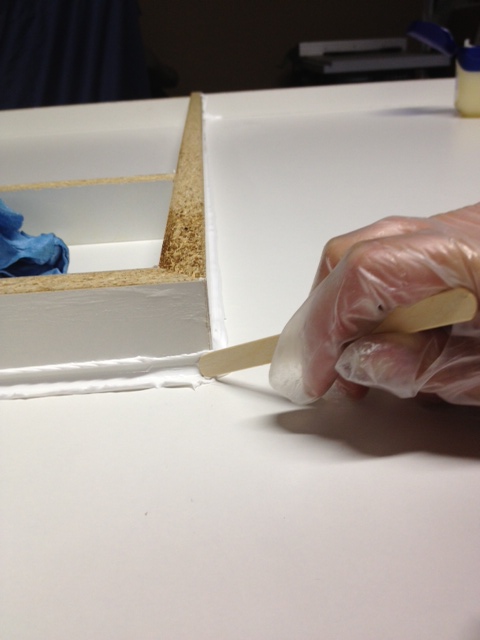
Wipe off your Popsicle stick frequently and don’t let excess caulk build up. It is important to push your Popsicle stick against both sides of the form and get a nice clean rounded corner. Now walk away and let it dry. Really. Leave all that gooped over the sides caulking and go get a coffee. Let it dry (ideally overnight) but a couple hours will do.
Then just pull off the excess caulking to reveal a perfect edge. (it comes off so easily because of the Vaseline!)

Awesome, right?!
Step Seven:
Pat yourself on the back, cause now you have some awesome Concrete Countertop Forms!
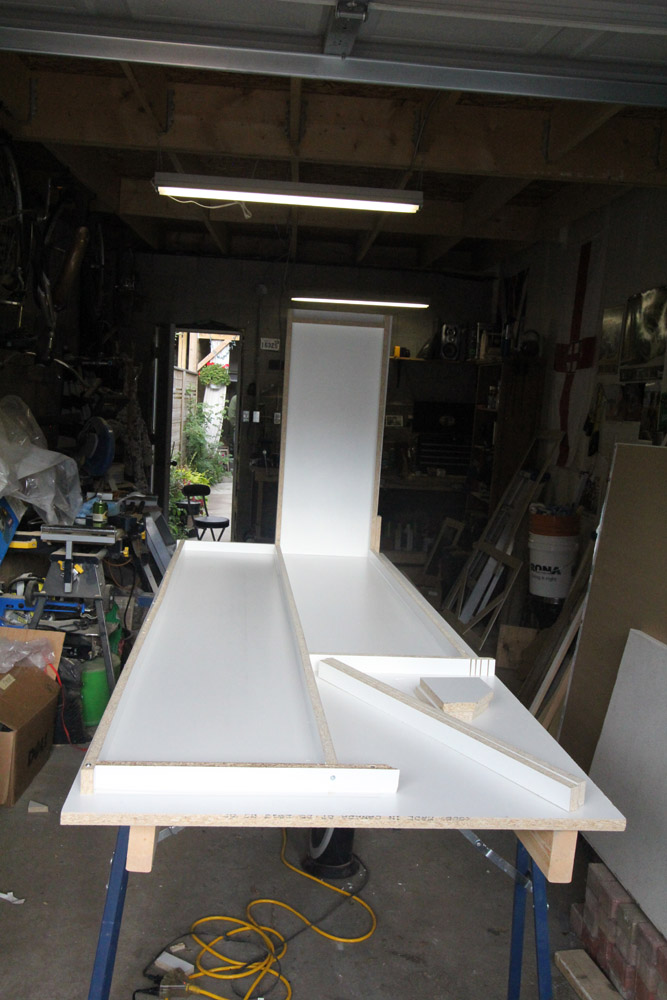
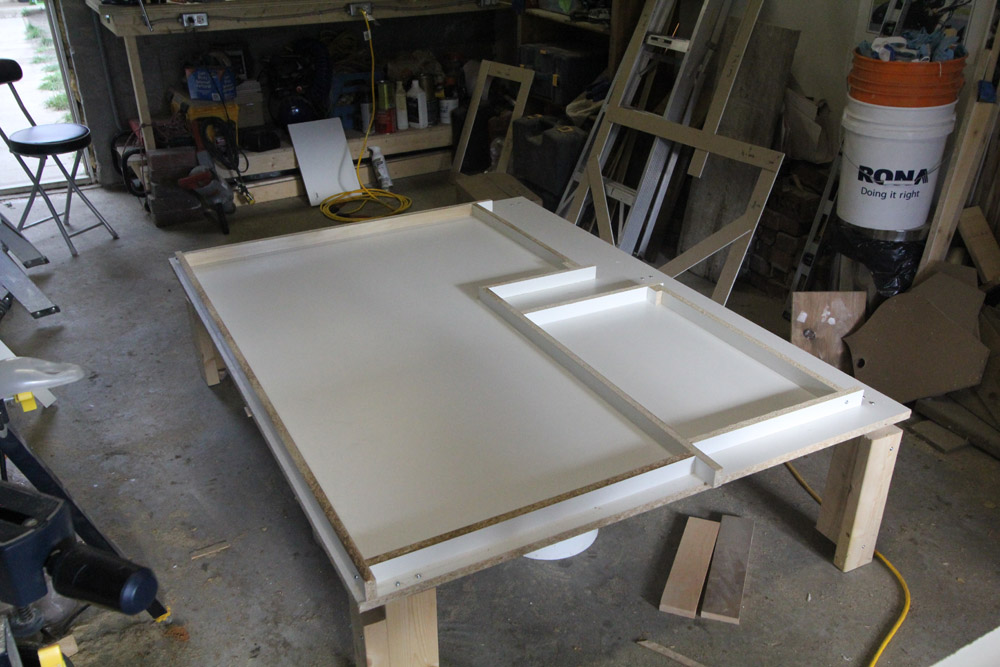
The forms are built, everything is ready to go! Next up we POUR!
This project is part of Project Concrete Countertops. Make sure you check out the rest of the series starting with Concrete Countertops – The Mix, The Templates, The Forms, The Pour, Fill & Sand,The Reveal and Finishing Touches.
*We were gifted some (awesome) Buddy Rhodes Concrete Products, but all opinions are our own!

Hi Kristen, thank you for answer me. the information I would like it is the small overhang on the entire countertop. I saw the waterfall wich I love but I am scare to go over my head. Since I wrote to you, I went to the site of the products; and I saw that they sale dvd. Do you think I need them or should I look at more video on you tube for more explinations? I follow your link and I can see it was a lot of work. You did an amazing job!!!
P.S. YOU CAN GET MINERAL SPIRITS at art supply store such “OMER DE SERRE”
I am french so I never, never, question on anything BUT THIS I follow as much as I could; read step by step, did not quite get how to do the overhang so I went on you tube to see if I could get it there, no chance there, even with the Buddy rhodes’one. So, I came back here to follow the last step but IT IS NOT THERE!!! Is it coming soon? Can you suggest me some videos that explain how to do the overhang?
Hi Lise,
Are you wanting info on the small overhang over the entire countertop, or the waterfall? If it is the waterfall, you can see how we made the form in Step 5. You can see how the concrete is added to that form in this post http://www.storefrontlife.com/diy-concrete-countertops-the-pour/ . I would be happy to answer any specific questions!
Hi Kristen, thank you for answer me. the information I would like it is the small overhang on the entire countertop. I saw the waterfall wich I love but I am scare to go over my head. Since I wrote to you, I went to the site of the products; and I saw that they sale dvd. Do you think I need them or should I look at more video on you tube for more explinations? I follow your link and I can see it was a lot of work. You did an amazing job!!!
We covered the overhang in our template post here http://www.storefrontlife.com/concrete-countertop-templates/ we made our counters 3/4″ deeper on the areas we wanted it to overhang. I would recommend getting a video and/or books. They are much better at explaining things than I am!
thank you so much for the info.
Hello! I’ve been reading your site for a long time now and finally got the bravery to go ahead and give you a shout out from New Caney Tx! Just wanted to say keep up the great work!
The suspense builds…! Can’t wait to see this. Especially the waterfall. Vertical concrete? Craaaazy.